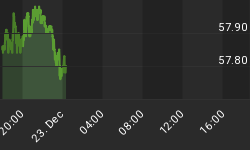Financial stocks had been treading water relative to the S&P 500 for the past six weeks. That changed late yesterday after J.P. Morgan announced a dividend increase and stock buyback program.
While the chart below looks complex, the concepts are easy to understand. The chart shows the performance of financial stocks relative to the S&P 500 Index. Here are the key takeaways for investors:
- The thin colored lines are shorter-term moving averages, which filter out some of the day-to-day volatility in price. The black dotted line is price, or financials relative to the market. The long-term moving average, the 200-day, recently intersected with the shorter-term moving averages. Yesterday, price spiked above the intersection of the moving averages in a bullish manner. The tight "cluster" of moving averages represented strong resistance; now they represent strong support.
- At the top of the chart, MACD, a measure of momentum, experienced a bullish cross on Tuesday (black line moved above red line).
- RSI, below price, has transitioned from a "bearish look" (see orange box) to a "bullish look" (green box), which tells us the odds favor further intermediate-term strength in financial stocks relative to the S&P 500.
- At the bottom of the chart, another momentum indicator, Wm %R, held above -80 during recent corrections, which is indicative of a market that is gaining traction.

A "retest" of the moving averages above may occur in the coming days. If the breakout fails to hold, it would be a negative for the entire market. If you want to take a more skeptical view of yesterday's action, RSI did not make a new high with price in the chart above.
As shown below, homebuilders experienced a similar moving average cluster in mid-October, which was followed by a period of outperformance. A similar "breakout" from a moving average cluster occurred on Tuesday of this week. The green box shows where the shorter-term moving averages crossed the 200-day - another bullish signal. Also note the RSI similarities between homebuilders and financials (compare the green rectangles above and below).

Similar to the breakout in financials, RSI did not confirm the move in homebuilders on Tuesday. A failure to hold a breakout is always a possibility.
How does all this help us? Given what we know today, which is subject to change, the odds favor continued outperformance by financials and homebuilders. Things can turn quickly in today's world, but when bank stocks are healthy it tends to be good for stocks in general. If the breakouts fail, it will send up a "be careful" flare for risk in general.
















